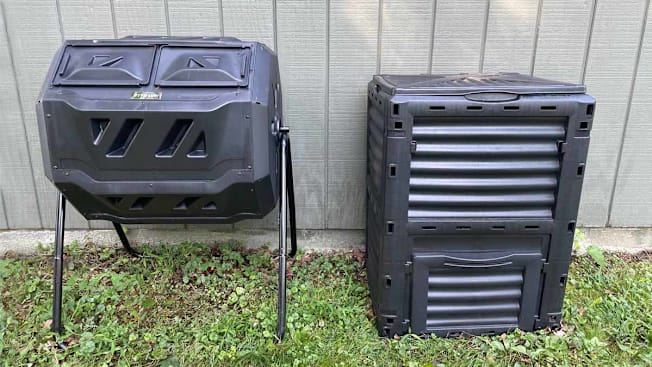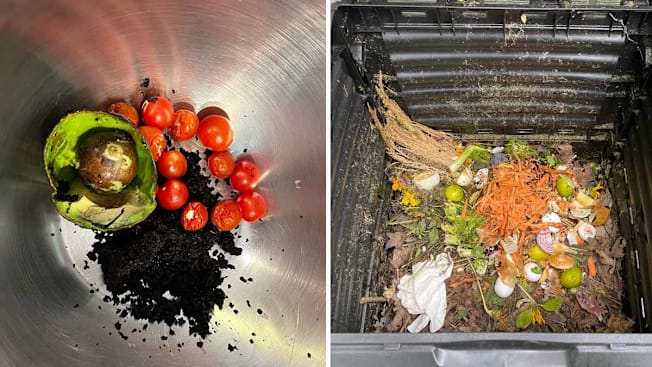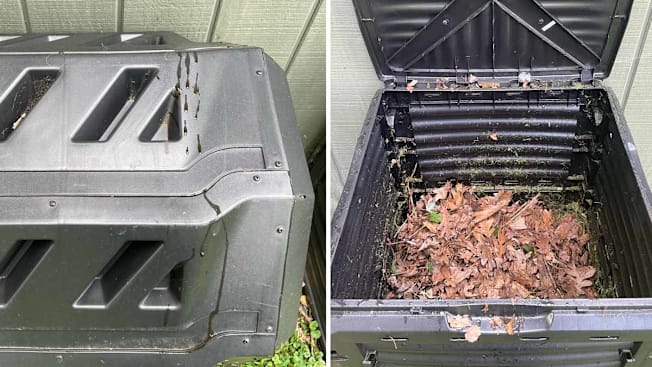Compost Bin Face-Off: Rotating Barrels vs. Box-Style Composters
The best compost bin is the one you’ll actually use. I tried two popular styles and have a clear favorite.
When you shop through retailer links on our site, we may earn affiliate commissions. 100% of the fees we collect are used to support our nonprofit mission. Learn more.

The promise is simple. A small backyard setup is supposed to transform all sorts of kitchen waste into a nutrient-dense compost, a material so prized by gardeners that they gave it the nickname “black gold.”
That said, four months into my first foray at composting, I started to suspect something was wrong. I’d been dutifully saving apple cores, coffee grounds, and a litany of other kitchen scraps for my compost piles. I faithfully churned the piles and periodically fed them with equal quantities of dried leaves and grass clippings to maintain the right ratio of nitrogen and carbon. Yet I had little to show for my efforts, except for what I can only describe as large piles of rotting food scraps, engulfed in fruit flies.

Photos: Paul Hope/Consumer Reports Photos: Paul Hope/Consumer Reports
Second, I wasn’t adding enough water. When I started, I noted that both compost bins looked pretty permeable, and I figured that whatever rainwater snuck in would be enough to sustain the decomposition needed.
What I forgot to consider was that if you’re counting on rainwater for, well, anything, it needs to actually rain. Much of New York State had a lengthy drought that lasted throughout the fall last year. I let my piles dry out, stalling their progress. It wasn’t until the recent rainy weeks of spring that I started to see some progress, which in turn inspired me to resume churning the compost from time to time.
I could’ve easily avoided this by periodically spritzing down the piles with a hose. While my first batch of compost isn’t quite finished, I am newly confident that I’m no longer on some fool’s errand, and that I’ll even have finished compost in a few weeks. I’m also confident that I’ve used both bins enough to weigh in on which represents a better design.
What’s the Best Compost Bin?
If you do a quick search for outdoor compost bins, you’ll find thousands of options. Nearly all will be from brands you’ve never heard of, and if I had to guess, they probably all come from a handful of factories and simply get stamped with slightly different names. But the vast majority fall into one of two styles.
The first style is more or less a rectangular box that rests on the ground.
This style typically has a lid on top, like a garbage can, which allows you to add new organic material. This style also typically has a small access door near the bottom of the bin, so you can access compost as it forms. If you want to turn or churn the compost, you lift up the lid and churn the contents with a shovel or pitchfork. Capacities range from about 60 gallons up to 120 gallons. Ours was made by a brand called JupiterForce, and the 80-gallon version we tested sells for about $35.
The second style of compost bin is barrel-shaped and is designed to spin freely, while suspended in a metal frame that rests on the ground. You can tumble the compost periodically to promote even decomposition.
Most spinning models I’ve seen divide the barrel into two separate composting chambers, each with a sliding plastic access door. The idea here is that you can make two batches of compost at once. That means you can start your second batch when the first is halfway formed. Staggering the batches gives you a steadier supply of compost through the gardening season, rather than one giant bumper crop all at once. Most models I’ve seen range from a capacity of 22 gallons up to 65 gallons. My model has a capacity of 43 gallons. It was made by Vivosun, and it sells for about $80.
Naturally, you will find options that don’t fall neatly into either of these two categories. There are tumbler-style models that are perfectly cylindrical, and bin-style models with open sides. You’ll also find totally different styles, including expandable circular bins with slits in the side to promote air exchange.
However, the compost bins I picked are extremely popular models, and are reflective of the most common styles. Their sizes sit squarely in the middle of the range you’ll find when shopping.
Each of the two designs offers some advantages, and the decision comes down to personal preference.
The spinning barrel style is the clear winner when it comes to churning your compost. You can spin it like the Big Wheel from The Price is Right, and the contents tumble together.
However, the spinning versions are usually more expensive than the simple box style—twice as much in my case. And each compartment only holds half as much. The openings are relatively small, so you need to add material one handful at a time. And you can’t really see too far inside, so when you want to clean it out or remove compost, you’re probably just gloving up and hoping for the best.
I prefer the bin style. It works like a bottomless garbage can, with a lid that flips up easily and a design that allows easy access. That makes it far easier to load up with shovelfuls of leaves and grass clippings, though when it’s fully loaded, it can be hard to churn the deep pile of debris, particularly the stuff near the bottom.
The basic idea here is that you can start a compost pile inside the bin, and continue to add more material as needed. The matter on the bottom is the oldest, and will break down first, at which point you can open a small trap door on the front of the box to shovel out the fully formed compost, allowing the next layer to drop down.

Photos: Paul Hope/Consumer Reports Photos: Paul Hope/Consumer Reports
Finally, I found that the barrel model I tried leaked. If you’ve had rain recently and go to tumble your compost, the liquid that collects inside the bin can ooze out around the door. A Reddit forum on the topic suggests this isn’t unique to the model I tried, either. One user hypothesized that the bins actually shouldn’t be water-tight, or they’d get pretty funky.
My bin-style compost container leaked, too, but it was from the bottom. I didn’t need to touch that slime to open the lid, let alone risk getting sprayed by it while turning over the compost.
For the spinning compost bin, the leakage was not a total deal-breaker, but it did make a slightly gross process a little grosser than it needed to be.
Tips for Composting Successfully
First, it’s worth getting a compost bin, unless you’ve got a sizable property and plan on making far more compost than a typical bin can handle.
In my somewhat modest suburban yard, I found that having a compost bin worked to contain odors and keep things looking tidy. I also didn’t notice mice, groundhogs, or squirrels hanging out around the bins, despite the abundance of temptations.
Regardless of which type of bin you use (or whether you use a bin at all), there are a few tips for effective composting that I wish I’d known from the start.
Balance greens and browns. Compost ingredients fall into two categories: greens and browns, and you should have roughly equal amounts of each. Green materials, as you might guess, are often (though not always) green. These tend to be rich in nitrogen, which is a crucial element for feeding soil. Think grass clippings, fruit, and veggie scraps. This category also includes other material like egg shells, coffee grounds and paper filters, and paper tea bags.
Browns have a much higher carbon-to-nitrogen ratio, and they include materials like dried leaves, wood chips (as long as they’re ground from untreated wood), stalks, twigs, and shredded paper or cardboard that doesn’t have labels, tape, or a glossy finish (like you’d find on wax paper).
I found that I did not produce green and brown organic matter in equal amounts. Some weeks saw more packages, and thus, more cardboard, while others sadly saw an excess of slimy zucchini, discovered in the depths of my crisper drawer. To keep things balanced, I used grass clippings and dried leaves from my yard.
Aerate sufficiently. The organic material in your bin needs to be tossed periodically to help it break down evenly. With a barrel-style bin, you can just spin the barrel a few times each time you add scraps. With a barrel bin, I found it easiest to toss or churn the material with a pitchfork or small Swiss army shovel. Aim to churn the contents once per week.
Keep it moist. As I learned the hard way, compost needs to stay moist. Both bins we tried allowed in some rainwater. Depending on the conditions in your area, that may provide enough moisture. Spray down the compost with a little water if it gets too dry. Throughout the entire process, it should have the consistency of a wrung-out sponge.
















